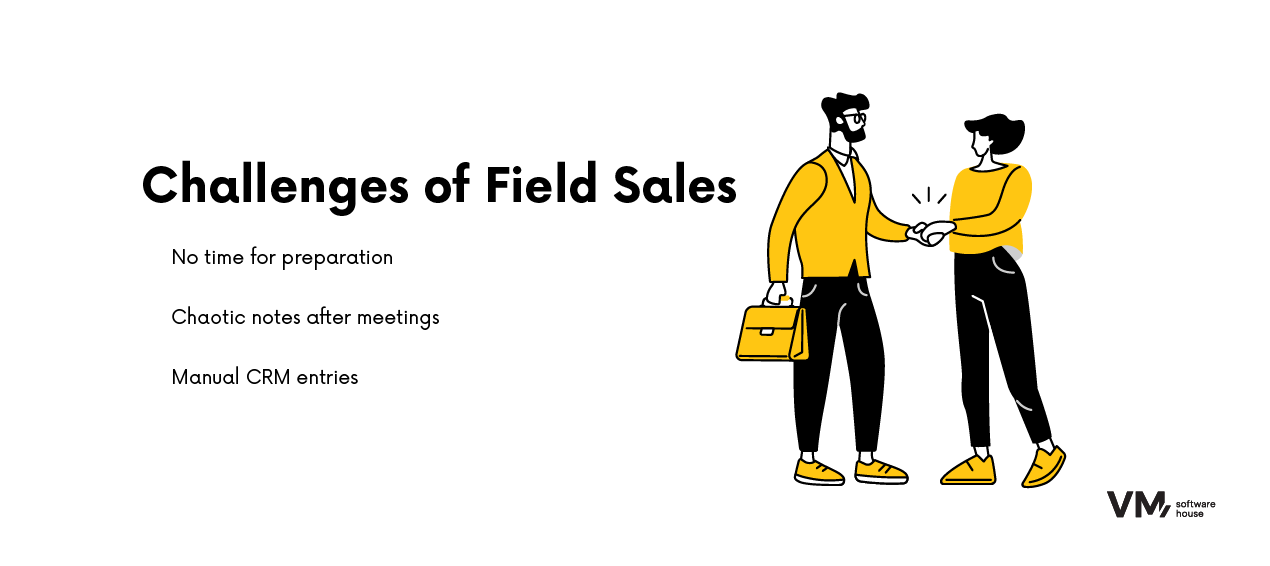
Table of Contents
Challenges faced by field sales representatives — from preparation to follow‑up
The daily routine of a field sales rep often means rushing and constantly adapting to changing circumstances. Meetings are scheduled back-to-back at various locations, and the time between them is too short to thoroughly review documentation, check price lists, or prepare for conversations. Additionally, there’s pressure to immediately demonstrate to the client that you understand their needs and fully comprehend your offer.
Taking notes during or after meetings is equally demanding. It’s often done in the car just after the conversation, using a phone or laptop. Under those conditions, mistakes happen easily, and some information simply slips away. Additionally, manually entering follow-up tasks into the CRM eats up more time and can be burdensome. As a result, the sales rep spends much of the day on administrative tasks instead of focusing on building client relationships.
Implementing AI assistants results in real time savings. Automating administrative tasks can reduce their share by up to 30%, and users of such solutions report saving an average of 12 hours per week. That equals nearly a full working day each week, which a sales rep can devote to client conversations instead of bureaucracy.

A voice assistant based on an LLM — how it works
Thanks to the development of large language models (LLMs) and automatic speech recognition (ASR) technologies, supporting sales reps can now look completely different. A modern voice assistant powered by an LLM becomes a mobile partner who knows all company materials and can suggest the best solutions in real time.
The foundation of such a system is grounding the language model in the company’s internal knowledge base—training materials, product documentation, sales presentations, and conversation scripts. This way, the AI agent understands the specifics of the offering, knows the differences between product variants, and masters terminology characteristic of the business. The rep no longer needs to wonder where to find the right information—they simply ask their voice assistant.
With text-to-speech (TTS), the communication is completely voice‑driven. The sales rep can talk to the agent in the car, hallway before a meeting, or even on the way to the next appointment. For example, they might ask: “What’s the best way to present the premium option to a client from the service sector?” — and the voice assistant provides ready-made talking points, including features and benefits most relevant to that type of client.
This assistant does more than just answer. It suggests the structure of the entire sales conversation, reminding reps of proven techniques: starting with opening the dialogue and diagnosing needs, moving on to presenting solutions, preparing counters to typical objections, and planning how to close the meeting. This enables even less‑experienced reps to conduct conversations like professionals, while experienced ones gain structured support in guiding the conversation’s flow.

CRM Integration – a Complete Voice‑Driven Workflow
Even greater benefits emerge when the voice assistant is integrated with the CRM system. That’s where the full customer history lives: previous transactions, payment statuses, order details, or open support tickets. Thanks to this integration, the sales rep doesn’t need to reach for a computer or mobile app. They simply ask: “What’s the payment status for customer Kowalski?” — and the voice agent instantly reads the data and provides the most important information.
Conversely, after a meeting, the rep doesn’t need to find a moment to manually enter notes. They just say: “Note – customer interested in premium option, requests an offer by end of week, remind me in three days.” The system automatically logs the note in the CRM, creates a follow‑up task, and sets a reminder. All of this happens via voice and in real‑time, without taking hands off the wheel or laptop.
The result is not only time savings but also better data consistency. Information flows into the system immediately, making it accessible to the whole sales team. There’s no risk of reps forgetting something or entering data days later when details may fade. As a result, sales managers gain a fuller and more accurate view of the pipeline.
Importantly, the AI does not have direct access to all data. Through an API gateway, only the necessary data fragments are shared for analysis, ensuring that trade secrets remain protected at every step.

The 4D Methodology – a Proven Framework for Building an AI Assistant
Developing an advanced voice assistant based on an LLM can’t be a shot in the dark. These implementations require structure, ensuring that the solution is not only technically robust but also aligned with real-world needs of sales teams. That’s why we employ a proprietary 4D methodology:
- Discovery: The exploration phase. We analyze current sales processes, challenges faced by reps, and technological barriers. We conduct workshops and gather training materials, documentation, and presentations. Discovery results in a map of needs and implementation priorities.
- Definition: The design phase. We define the assistant’s features, communication protocols, and system integrations — including CRM. We produce a detailed specification that aligns business requirements with technical constraints.
- Delivery: The execution phase. A prototype voice assistant is developed and trained on company materials, tested in real-life scenarios. Sales reps participate in pilot testing, and we gather feedback to refine the tool.
- Direction: The long-term evolution phase. The voice assistant isn’t static—it learns and grows with use. We monitor effectiveness, analyze results, and propose next steps like adding new languages, features, or integrations.
Thanks to the 4D methodology, the entire voice assistant deployment is structured, predictable, and secure. Clients can be confident the solution will work technically and deliver real business benefits: improved efficiency, better CRM data, and greater user comfort.

Strategic Impact of a Voice Assistant on Sales Organization
Implementing an LLM‑based voice assistant isn’t just a tech project—it’s a transformation of the entire sales organization. For directors and sales managers, it enables a shift from intuition‑driven leadership to data‑backed decision‑making and standardized processes.
With automated note-taking and follow‑up logging in CRM, management gains access to a fuller, more accurate, and real‑time snapshot of the pipeline. Better visibility translates into more accurate sales forecasting and faster identification of risks like delayed payments or dwindling customer engagement. Managers can base decisions on concrete, up‑to‑date information rather than fragmented reports.
The voice assistant also changes how sales reps work. Rather than spending hours on administration, they can focus on what truly adds value — building client relationships and closing deals. This leads not only to higher efficiency measured in meetings and closed sales, but also to greater job satisfaction. Field teams that feel supported by real technology work with more engagement and lower stress levels.

The Future of Voice Assistants in Sales
What we see today is just the beginning. In the coming years, voice assistants will become even more advanced by combining large language models (LLMs) with predictive analytics and data-driven personalization. This means the assistant won’t just suggest sales arguments—it will predict which ones are most likely to succeed in a given context.
Integrations with other technologies are also on the horizon. Imagine a voice assistant supporting sales reps during online meetings, offering real-time suggestions during video calls. Over time, it could even integrate with AR and VR solutions, enabling presentations in completely new and immersive formats.
A key direction for development is hyper-personalization. By connecting CRM data, contact history, and client preferences, the voice agent will be able to suggest not just the right message, but also the right tone of voice, communication style, and even the ideal timing for a follow-up.
All of this positions voice assistants not merely as support tools, but as full-fledged components of the sales ecosystem—empowering organizations to respond faster to market changes and build stronger client relationships.
Market forecasts are equally optimistic. According to 2025 data, the AI assistant market for sales has surpassed $3 billion and is growing at an annual rate of around 23–24%. This clearly shows that investing in such technologies isn’t a passing trend—it’s a lasting shift.

If you’re wondering how a voice assistant could transform your sales team, reach out to us. We’ll tailor solutions to your processes and show you how your reps can start benefiting from day one.













